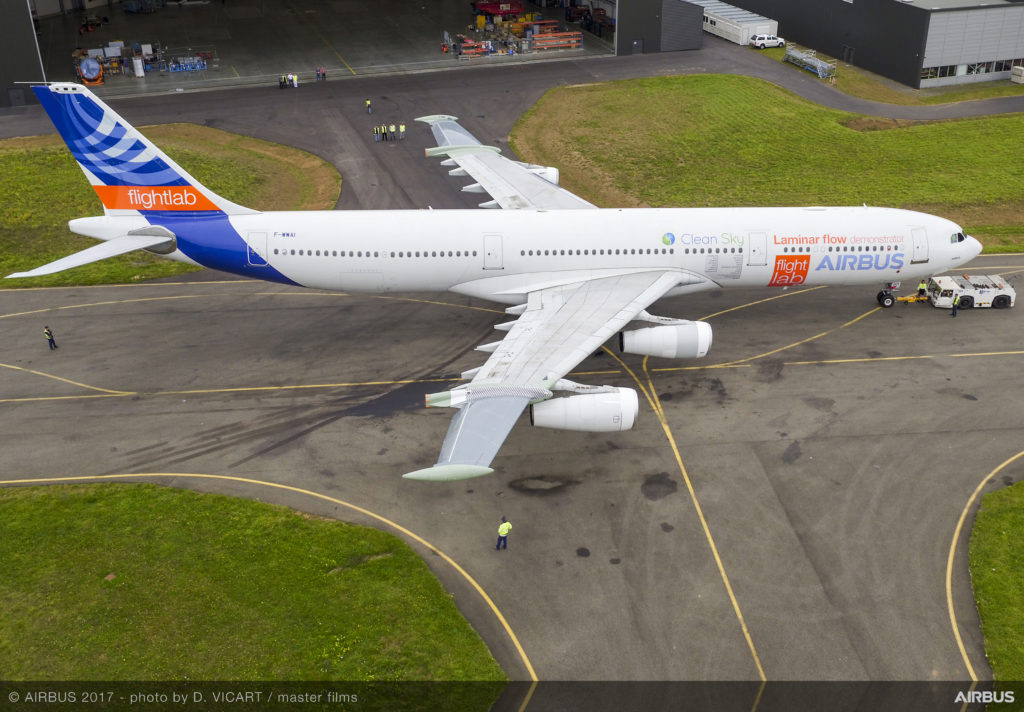Leeham News and Analysis
There's more to real news than a news release.
Bjorn’s Corner: Laminar flow aircraft
September 29, 2017, ©. Leeham Co: Airbus flew its “Blade” laminar flow research aircraft for the first time this week. It’s a project in the European Clean Sky research program.
The “Blade” aircraft is a modified Airbus A340-300, where the outer wings have been replaced with special laminar flow wing sections. We will spend a couple of Corners to understand why this research is done and why it’s important.
Laminar flow
The drag force of an aircraft makes it necessary to have engines on the aircraft, generating thrust to offset the drag. The higher the drag, the higher the fuel consumption.
Aircraft drag has two principle components for subsonic airliners. The drag due to size, called parasitic drag, and drag due to weight, called induced drag.
Of the two, the parasitic drag is the dominant part in most flight situations. Most of the parasitic drag is due to the air’s friction against the aircraft’s skin. The rougher and larger the aircraft skin, the higher the skin friction drag.
The parasitic drag for an Airbus A320 with 150 passengers on a typical two-hour flight is 5.000lbf at mid-weight (then flying at Flight Level 350, 35,000ft). The induced drag is then 2,500lbf.
This means the two engines need to counter 7,500lbf of drag. If we could reduce the drag we could reduce the engine thrust and thereby the aircraft’s fuel consumption.
Turbulent flow
The airflow near the aircraft skin is turbulent on more than 95% of the aircraft surface at these conditions. Turbulent flow creates more drag than if the surface could be made so the flow stayed laminar.
The difference in drag between laminar and turbulent flow is large. The parasitic drag could be halved if the flow could be kept laminar over most of the aircraft surface. This is difficult to achieve, but if the flow could be kept laminar on more than today’s initial 5% of the surface, a lot would be gained.
Blade research
It’s difficult to create aircraft surfaces that keep the airflow laminar over a larger proportion than 5%-10% of the aircraft surface. When the air hits, for example, a wing’s leading edge, the flow starts as laminar, but then quickly (within inches) turns turbulent.
To keep the flow laminar over a longer distance, one needs a smooth surface and a special curvature of the wing profile. This is what is researched with the Blade aircraft. It has special “laminar flow” outer wing sections, Figure 2.
How such surfaces are done and why they are difficult to introduce on production aircraft, we will cover in the next Corner.





Some similarities to the cresent shape wing on the HP Victor. An aircraft that still looked outlandishly futuristic in the gulf war in spite of being eons old and heavily butchered to fulfill the tanker role. Is there significance in the laminar flow wing having less wing sweep Bjorn?
I don’t know why fictional spacecraft often have this appearance, but I love it as well. Known as a crescent wing on the Victor. I either have forgotten why it’s that shape, or probably I couldn’t understand the explanation.
Anyone know of a good aerodynamics for idiots book?Has to be reasonably simple with not maths.
Supposed to say “not too much maths”,dislyksik as well
Can’t read either, I see that you already mentioned that it is called a crescent wing! Apparently stolen from the German Arado company after the second World War.
Betz the German aerodynamicist published his results just before the war. But only because only the Germans were doing the practical research and sweeping their wings, no one else took any notice till after 1945.
With the Victor the high sweep and high thickness in board had a couple of advantageous effects. One was the swept wing- fuselage aerodynamic issues were minimised ( also helped by the fuselage diameter being fortuitously the optimum for the thickness of the wing root). The other advantage from reducing the sweep as the thickness reduced further out was wash out from twist at higher speeds was reduced.
Like any wing design there were many conflicting parameters to be resolved as well as those mentioned.
Attachment line (LE) and crossflow instabilities are more prominent and lead to transition on swept wings.
I could probably find out, but I would hazard a guess that these tests might be conducted at a lower speed than the A340 wing was optimised for…
I can imagine that it’s easier to control the airflow at a lower speed, also that they will be looking at stall onset.
Bjorn, one request: Could you please use SI units in your calculations? I’m really interested in this matter and I bet most people who are would love to see international units. In the end this is about science, not buying groceries. Thanks a lot for your work!
I quote drag in Imperial units as engine thrust is traditionally in lbf (Pound force). Multiply by 4.45 and you have it in N.
I aggree, it would really simplify to read your great texts. Maybe you can write them in brackets behind the imperial units?
Has anyone researched converting the oxygen to ozone by exposing it to UV light at the beginning of the laminar flow area?
Why would one want to do that?